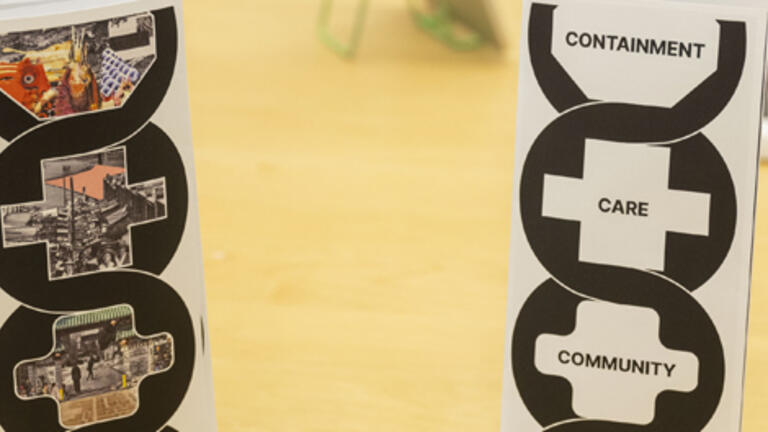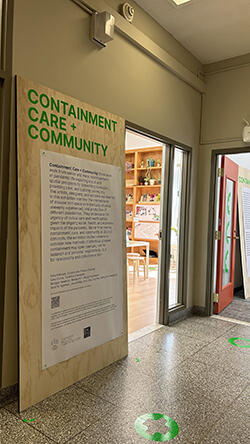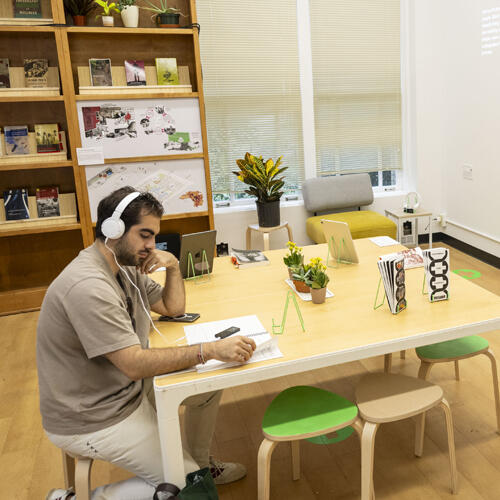Reflecting on Pandemic Life through Containment, Care + Community Exhibition


Last week, the Joseph Ballay Center for Design Fusion debuted Containment, Care + Community, a six-day exhibition of work from earlier and more recent periods of pandemic life exploring social and spatial prospects for preventing contagion, providing care, and building community. The show was curated and directed by the School of Architecture’s Nida Rehman and was sponsored by Carnegie Mellon University’s Center for Arts in Society. It was the premiere exhibition in the new Joseph Ballay Center for Design Fusion, which serves as a central hub for design courses for the CMU campus community, executive education, sponsored projects and collaborations, and design research. The exhibition showcased a diverse body of student work including pandemic-related studies, proposals and critical explorations compiled over the last three years. Student projects were presented alongside scholarly texts from a range of multidisciplinary fields, including urban studies, history of medicine, medical anthropology, public health, sociology, architecture history, and more. Exhibition visitors were invited to engage in the subject matter through text-based works and audio and visual presentations.
Projects represented in the exhibition examined “the intersections of disease and space as historically-situated, unevenly experienced, and productive of different possibilities,” Rehman explains. “Against the discourse of a 'post-pandemic' normality, they underscore the urgency of radical care and health justice given the ongoing social, health, and economic impacts of the pandemic.” In viewing the exhibit, visitors were encouraged not to view “containment, care, and community as distinct concepts,” but to consider “how methods of infectious disease containment may open avenues, not for isolation and personal responsibility, but for relationality and collective action.”

The three themes of the exhibit were chosen for their respective relationships with pandemic governance and outcomes. The theme of Containment referred to “experiences and policies of isolation and containment,” says Rehman. “Projects in this section demonstrate the entanglement of hygienic and social borders.” These included student work from Rehman’s 2020 advanced architecture design studio, Landscapes of Disease and Health, as well as work inspired by themes explored in the one-day symposium, Public Health, Private Spaces in October 2022. The symposium focused on “the reconfigured borderlines between personal-professional, home-work, safety-danger and public-private, and unpack the paradoxes of circulation and isolation: how certain groups move and live freely, while the capacities of (racialized, classed, disabled…) others are already always constrained.”

“The COVID-19 crisis was, and remains, a crisis of care,” Rehman explains. “Just as the pandemic shed light on the structural crises of care, it also provided models to revalue the labors and spaces of caring.” In tandem with Community, projects in this section explored “possibilities for pushing back against the forces of structural individualization and abandonment to create forms and networks of collective care.” To explain the third theme of Community, Rehman references the “constant refrain in the first few months” of the pandemic: “We are all in this together.” “Despite avowals of interconnectedness, solidarities across lines of class, race, caste, and ability remain tenuous when it comes to policies and practices to protect the most vulnerable.” With this context in mind, the projects in this section were showcased “alongside a collection of multidisciplinary scholarship on health, space, care, and justice.” The works were presented within a community reading and viewing area that allowed visitors the opportunity to reflect on the subject matter. “This theme invites people to pause and sit together in community and in solidarity,” says Rehman.
“This was a great opportunity for the Ballay Center to pilot a robust exhibition in our spaces. Containment, Care + Community was modular yet integrated with the Ballay Center rooms. It was expertly crafted, visually impactful, and intellectually rich,” says Director of the Ballay Center, and Professor/Chair of Product Design, Mark Baskinger.
Special thanks to Nida Rehman (Curator and Project Director), Ilana Curtis (Exhibition Designer) and Morgan Newman (Research + Design Assistant) for their wonderful job creating Containment, Care + Community.